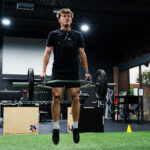Strength Gains Through Sports Performance Training
Strength is the foundation of power, speed, agility, and resilience in sports. Without it, performance suffers, and injury risk increases. That’s why smart athletes make sports performance training focused on strength a top priority.
In this article, you’ll learn how strength boosts athletic ability, what exercises to include, and how to avoid common training mistakes.
Why Strength Training Matters in Sports
Strength in sports isn’t about lifting the heaviest weights. It’s about producing force quickly and controlling your body efficiently.
Benefits of strength-focused sports performance training include:
-
Increased power and explosiveness
-
Better control and balance during fast movements
-
Enhanced joint stability and injury prevention
-
Improved speed, vertical jump, and change of direction
-
Greater endurance and confidence in competition
The National Strength and Conditioning Association (NSCA) emphasizes that strength is a critical component in developing all other physical qualities.
How Strength Enhances Athletic Performance
Here’s how strength boosts various aspects of performance:
-
Acceleration: Strong legs drive faster starts and sprints
-
Agility: Core and leg strength help control quick changes in direction
-
Jumping: More strength means higher verticals and longer bounds
-
Stamina: Strength improves movement efficiency, reducing fatigue
-
Injury resistance: Strong muscles and tendons protect against tears and sprains
Without proper strength, athletes may move well—but only for a short time. Fatigue and breakdown quickly follow.
Best Exercises for Sports Strength
Focus on compound lifts and explosive movements. These mimic real sports demands and build transferable strength.
1. Trap Bar Deadlift
Full-body lift with minimal back strain
How to do it: Stand inside the bar, grip handles, and lift using hips and legs.
2. Bulgarian Split Squat
Targets legs, glutes, and core
How to do it: Elevate rear foot on bench, lower front leg slowly, and drive up.
3. Hang Power Clean
Builds explosive hip power
How to do it: From a hang, extend hips and catch bar at shoulders.
4. Pull-Up
Improves upper-body pulling strength
How to do it: Use full range of motion; scale with bands if needed.
5. Front Squat
Improves posture, core, and quad strength
How to do it: Hold bar on shoulders, keep chest up, and squat deep.
6. Medicine Ball Slam
Adds power and aggression
How to do it: Lift ball overhead and slam it forcefully to the ground.
These moves should anchor your sports performance training plan, 2–3 days a week.
How to Structure a Strength Program
A smart weekly strength routine looks like this:
| Day | Focus | Example Exercises |
|---|---|---|
| Monday | Lower Body Power | Trap bar deadlifts, box jumps |
| Wednesday | Upper Body Strength | Pull-ups, incline presses, rows |
| Friday | Total Body Explosive | Hang cleans, med ball slams, squats |
Each session should include:
-
Dynamic warm-up
-
3–5 main lifts
-
Core stability work
-
Recovery and mobility work
Progressive overload is key: add reps, weight, or intensity each week.
Mistakes to Avoid in Strength Training
Even experienced athletes make strength training errors. Avoid these:
-
Poor form: Technique matters more than weight
-
Skipping warm-ups: Cold muscles are injury-prone
-
Neglecting recovery: Sleep and rest days are critical
-
Overemphasizing isolation: Focus on full-body, sport-specific lifts
-
No plan: Random workouts lead to random results
Stay consistent, track your progress, and use rest periods wisely for maximum gains.
Core Training for Functional Strength
Strong abs aren’t just for show—they stabilize your spine and improve force transfer.
Add these to your sports performance training routine:
-
Dead bug
-
Plank variations
-
Pallof press
-
Cable woodchopper
These develop true core strength that enhances balance, posture, and injury prevention.
Mobility and Recovery Support Strength Gains
Flexibility and recovery are essential to sustain strength progress. Prioritize:
-
Dynamic stretching before workouts
-
Foam rolling post-training
-
Static stretching after sessions
-
Hydration and nutrition daily
-
Sleep (8+ hours)
Neglecting recovery stalls progress and increases injury risk. Remember: strength is built during rest, not just lifting.
For personalized guidance and expert coaching, check out Next Level Athletics. Their programs are tailored to help athletes develop full-body sports performance training strategies that build elite-level strength.
Strength and Youth Athletes
Strength training is safe for youth—when done correctly. It improves coordination, motor control, and sports readiness.
Tips for training youth:
-
Use bodyweight and light resistance
-
Teach proper form early
-
Keep sessions short and fun
-
Focus on movement, not max lifting
-
Supervise and support progress
Strength training builds confidence in young athletes and sets a solid foundation for long-term development.
Conclusion: Strength Powers Every Play
Every sprint, jump, cut, or shot in sports starts with strength. By training it properly, athletes unlock their full potential. A structured sports performance training plan, focused on full-body strength and explosive movement, builds power, protects joints, and leads to better results on game day.
Train smart, stay consistent, and grow stronger every week.


Recent Comments